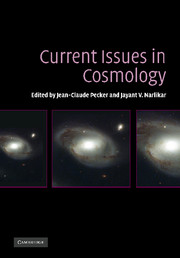Book contents
- Frontmatter
- Contents
- List of contributors
- Preface
- Part I Observational facts relating to discrete sources
- Part II Observational facts relating to background radiation
- Part III Standard cosmology
- 7 Cosmology, an overview of the standard model
- 8 What are the building blocks of our Universe?
- Part IV Large-scale structure
- Part V Alternative cosmologies
- Part VI Evidence for anomalous redshifts
- Part VII Panel discussion
- Index
7 - Cosmology, an overview of the standard model
Published online by Cambridge University Press: 15 December 2009
- Frontmatter
- Contents
- List of contributors
- Preface
- Part I Observational facts relating to discrete sources
- Part II Observational facts relating to background radiation
- Part III Standard cosmology
- 7 Cosmology, an overview of the standard model
- 8 What are the building blocks of our Universe?
- Part IV Large-scale structure
- Part V Alternative cosmologies
- Part VI Evidence for anomalous redshifts
- Part VII Panel discussion
- Index
Summary
Abstract
The full recognition of the genuine expansion of the Universe and all its consequences is what led to the construction of the “hot big-bang” scenario. The reasons why it is now widely accepted as the standard model of cosmology are reviewed. They are all related to the fact that, if matter and energy are to be conserved in an expanding Universe, its content gets diluted over cosmological time implying that it has experienced a thermal history. Many physical phenomena associated with this evolution have been identified, the signatures of which have been actively looked for and indeed been found in a series of crucial observations, from big-bang nucleosynthesis to the patterns expected from the gravitational growth of structure of the Universe.
What is well established, what is speculative, and the questions that are left totally unanswered in the standard cosmology scenario are succinctly presented.
Introduction
Most modern cosmologists would certainly agree that the rapid and recent progress in observational cosmology has put the standard model of cosmology, what is often referred to as the hot-big-bang scenario, on increasingly solid ground. Since the discovery by Hubble in 1929 of the apparent expansion of the Universe from the observed tendency of the faint galaxies to be redshifted, the idea that the Universe is expanding has attracted the attention of many astrophysicists. It led to the idea that the Universe, rather than being in some sense immutable, was born from a primordial explosion, a “Big Bang.” As will be discussed in the conclusions, the issue of the “birth” of the Universe is actually beyond the standard cosmology theory.
- Type
- Chapter
- Information
- Current Issues in Cosmology , pp. 87 - 100Publisher: Cambridge University PressPrint publication year: 2006



